Systematic trans-genomic comparison of protein kinases between Arabidopsis and Saccharomyces cerevisiae
- PMID: 12913170
- PMCID: PMC181299
- DOI: 10.1104/pp.103.021485
Systematic trans-genomic comparison of protein kinases between Arabidopsis and Saccharomyces cerevisiae
Abstract
The genome of the budding yeast (Saccharomyces cerevisiae) provides an important paradigm for transgenomic comparisons with other eukaryotic species. Here, we report a systematic comparison of the protein kinases of yeast (119 kinases) and a reference plant Arabidopsis (1,019 kinases). Using a whole-protein-based, hierarchical clustering approach, the complete set of protein kinases from both species were clustered. We validated our clustering by three observations: (a) clustering pattern of functional orthologs proven in genetic complementation experiments, (b) consistency with reported classifications of yeast kinases, and (c) consistency with the biochemical properties of those Arabidopsis kinases already experimentally characterized. The clustering pattern identified no overlap between yeast kinases and the receptor-like kinases (RLKs) of Arabidopsis. Ten more kinase families were found to be specific for one of the two species. Among them, the calcium-dependent protein kinase and phosphoenolpyruvate carboxylase kinase families are specific for plants, whereas the Ca(2+)/calmodulin-dependent protein kinase and provirus insertion in mouse-like kinase families were found only in yeast and animals. Three yeast kinase families, nitrogen permease reactivator/halotolerance-5), polyamine transport kinase, and negative regulator of sexual conjugation and meiosis, are absent in both plants and animals. The majority of yeast kinase families (21 of 26) display Arabidopsis counterparts, and all are mapped into Arabidopsis families of intracellular kinases that are not related to RLKs. Representatives from 11 of the common families (54 kinases from Arabidopsis and 17 from yeast) share an extremely high degree of similarity (blast E value < 10(-80)), suggesting the likelihood of orthologous functions. Selective expansion of yeast kinase families was observed in Arabidopsis. This is most evident for yeast genes CBK1, HRR25, and SNF1 and the kinase family S6K. Reduction of kinase families was also observed, as in the case of the NEK-like family. The distinguishing features between the two sets of kinases are the selective expansion of yeast families and the generation of a limited number of new kinase families for new functionality in Arabidopsis, most notably, the Arabidopsis RLKs that constitute important components of plant intercellular communication apparatus.
Figures

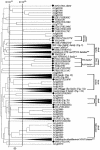


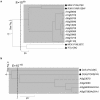
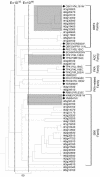
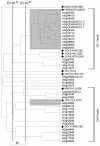

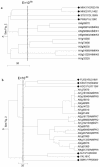
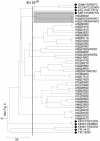

Similar articles
-
The Arabidopsis Kinome: phylogeny and evolutionary insights into functional diversification.BMC Genomics. 2014 Jul 1;15(1):548. doi: 10.1186/1471-2164-15-548. BMC Genomics. 2014. PMID: 24984858 Free PMC article.
-
Genome-Wide Expression Pattern Analyses of the Arabidopsis Leucine-Rich Repeat Receptor-Like Kinases.Mol Plant. 2016 Feb 1;9(2):289-300. doi: 10.1016/j.molp.2015.12.011. Epub 2015 Dec 19. Mol Plant. 2016. PMID: 26712505
-
Expansion of the receptor-like kinase/Pelle gene family and receptor-like proteins in Arabidopsis.Plant Physiol. 2003 Jun;132(2):530-43. doi: 10.1104/pp.103.021964. Plant Physiol. 2003. PMID: 12805585 Free PMC article.
-
Ancient signals: comparative genomics of plant MAPK and MAPKK gene families.Trends Plant Sci. 2006 Apr;11(4):192-8. doi: 10.1016/j.tplants.2006.02.007. Epub 2006 Mar 14. Trends Plant Sci. 2006. PMID: 16537113 Review.
-
Evolution of protein kinase signaling from yeast to man.Trends Biochem Sci. 2002 Oct;27(10):514-20. doi: 10.1016/s0968-0004(02)02179-5. Trends Biochem Sci. 2002. PMID: 12368087 Review.
Cited by
-
Chlamydomonas and Arabidopsis. A dynamic duo.Plant Physiol. 2004 Jun;135(2):607-10. doi: 10.1104/pp.104.041491. Plant Physiol. 2004. PMID: 15208408 Free PMC article. Review.
-
Gene and metabolite regulatory network analysis of early developing fruit tissues highlights new candidate genes for the control of tomato fruit composition and development.Plant Physiol. 2009 Mar;149(3):1505-28. doi: 10.1104/pp.108.133967. Epub 2009 Jan 14. Plant Physiol. 2009. PMID: 19144766 Free PMC article.
-
Crosstalk between Ubiquitination and Other Post-translational Protein Modifications in Plant Immunity.Plant Commun. 2020 Mar 25;1(4):100041. doi: 10.1016/j.xplc.2020.100041. eCollection 2020 Jul 13. Plant Commun. 2020. PMID: 33367245 Free PMC article. Review.
-
A NIMA-related kinase, Fa2p, localizes to a novel site in the proximal cilia of Chlamydomonas and mouse kidney cells.Mol Biol Cell. 2004 Nov;15(11):5172-86. doi: 10.1091/mbc.e04-07-0571. Epub 2004 Sep 15. Mol Biol Cell. 2004. PMID: 15371535 Free PMC article.
-
Expanding the Mitogen-Activated Protein Kinase (MAPK) Universe: An Update on MAP4Ks.Front Plant Sci. 2020 Aug 7;11:1220. doi: 10.3389/fpls.2020.01220. eCollection 2020. Front Plant Sci. 2020. PMID: 32849755 Free PMC article. Review.
References
-
- Arabidopsis Genome Initiative (2000) Analysis of the genome sequence of the flowering plant Arabidopsis thaliana. Nature 408: 796-815 - PubMed
Publication types
MeSH terms
Substances
Grants and funding
LinkOut - more resources
Full Text Sources
Molecular Biology Databases
Research Materials
Miscellaneous

